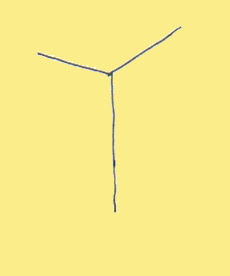
I found this "simple excersize" to be surprizingly difficult. Dustin, you're absolutely right about moving your head--it skews everything. After several failed attempts I made a little Perspective Analyzer--"Rene's Y." it's a simple diagram of the desired Cartesian three-angle intersect. Even that was hard to nail. I used a Postit and held it up at arm's length to check accuracy. I'd usually get one of the ceiling angles right, but then the other would be off.
If you stand in the center of a room and look at a corner, there will be a two-point perspective. If you stand very near one wall, the corner will have a one-point perspective.
The bigger outside corners of buildings don't move much the way the near ceiling corners seem to. But this is important stuff. We live in a grid-world where all the horizontal lines come crashing to the floor. Or at least to eye-level. Or else bend up to it. Amazing. Parthenon tweakage secrets. And we're locked into this world of descending grids. Hopping up and down makes it all jump, but dosn't free you from it. That's why drawings won't look right without some checking, at least, of the perspective angles.
FF
No comments:
Post a Comment